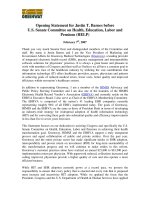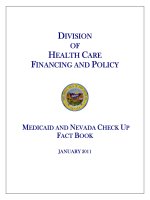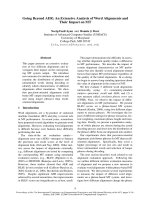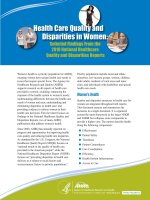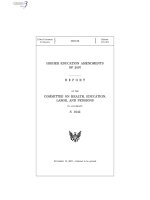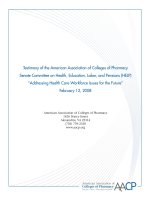KEy iNFORmATiON ON HEALTH CARE COSTS AND THEiR imPACT 2012 doc
Bạn đang xem bản rút gọn của tài liệu. Xem và tải ngay bản đầy đủ của tài liệu tại đây (3.35 MB, 44 trang )
HEALTH CARE
COSTS
A PRimER
mAy 2012
KEy iNFORmATiON ON
HEALTH CARE COSTS
AND THEiR imPACTHEALTH CARE COSTS: A PRimER
KEy iNFORmATiON ON
HEALTH CARE COSTS AND THEiR imPACT
mAy 2012
TABLE OF CONTENTS
Introduction 1
How Much Does the U.S. Spend on Health and How Has It Changed? 4
In 2010, the U.S. spent $8,402 per person on health care, and 18% of the U.S.
economy was devoted to health care. Health care spending is consuming an
increasing share of economic activity over time and has exceeded economic growth in
every recent decade, though rate of increase in national health spending has declined.
How Does U.S. Health Spending Compare with Other Countries? 7
The U.S. spends substantially more on health care than other developed countries. As
of 2009, health spending in the U.S. was about 90% higher than in many other
industrialized countries.
How Does Health Care Spending Vary by Person? 8
A small share of people accounts for a significant share of expenses in any year. In
2009, half of all health care spending was used to treat just 5% of the population.
Health care spending also varies by factors such as age and sex. Adults aged 65 and
older have the highest health care spending, averaging $9,744 per person in 2009.
What Do Health Expenditures Pay for and Who Pays for Them? 10
Most health care spending (about half) is for care provided by hospitals and physicians.
Private health insurance, Medicare, and Medicaid's shares of total spending have
increased over time, while out-of-pocket spending's share has decreased. Private
funds are the largest sponsor (55%) of total health spending.
How Do Health Care Costs Impact Families and Employers? 17
Families cut back on care and face financial consequences because of health care
costs, especially those with chronic medical conditions. Health insurance premium
increases consistently outpace inflation and the growth in workers’ earnings. Eligibility
standards for public programs such as Medicaid and CHIP do not keep pace with rapid
increases in the cost of health coverage.
Why Are Health Care Costs Growing Faster Than the Economy Overall? 25
Increasing expenditures on new medical technology is a primary factor. The U.S.
population is getting older and disease prevalence has changed. Insurance coverage
has increased. Americans pay a lower share of health expenses than they used to.
What Can Be Done to Address Rising Costs? 27
Some approaches for dealing with health care costs may reduce the level of spending
but not the rate of growth. Policies focusing on new and expanding technologies may
have success in reducing the rate of growth, but can be difficult to implement. While it
is clear that the ACA will expand coverage to the uninsured, its effects on health care
costs and the rate of increase in health care spending are less certain.
Conclusion 32
1
HEALTH CARE COSTS: KEY INFORMATION ON HEALTH CARE COSTS AND THEIR IMPACT
Key Facts
In 2010, the U.S. spent $2.6 trillion on health care, an
average of $8,402 per person.
The share of economic activity (gross domestic product, or
GDP) devoted to health care has increased from 7.2% in
1970 to 17.9% in 2009 and 2010.
Health care costs per capita have grown an average 2.4
percentage points faster than the GDP since 1970.
Since 2002, the rate of increase in national health care
spending has fallen from 9.5% to 3.9%.
Half of health care spending is used to treat just 5% of the
population.
Although only 10% of total health expenditures, spending
on prescription drugs has received considerable attention
because of its rapid growth (114% from 2000 to 2010).
In 2008, 27% of the nonelderly with 3+ chronic conditions
spent more than 10% of their income on health, compared
to 11% of the total nonelderly population.
Many policy experts believe new technologies and the
spread of existing ones account for a large portion of
medical spending and its growth.
Introduction
Health care accounts for a remarkably large slice of the U.S. economic pie. Each year
health-related spending grows, virtually always outpacing spending on other goods and
services, meaning that the size of that slice increases. These cost increases have a
significant effect on households, businesses, and federal, state, and local
governments. Among other things, rising health care costs make health insurance less
affordable for individuals, families, and businesses; put pressure on businesses that
offer insurance coverage to their employees; can be a major financial burden to
families, even those that have insurance; and can result in individuals not receiving the
health care services they need. For taxpayers, government programs such as
Medicare and Medicaid are major parts of federal and state budgets, and increasing
costs require either additional revenue or reductions in benefits, eligibility, or payment
rates.
Concerns about rising health care costs and affordability of health care for families
persist despite the enactment of comprehensive health reform legislation in March
2010 (the Affordable Care Act, or ACA).
1
The ACA changed the health care landscape
considerably by providing significant financial assistance to help people with low and
moderate incomes afford coverage and associated cost sharing. The law provides new
standards for private health insurance, including identifying minimum benefits for health
insurance, placing limits on cost sharing for covered benefits, and establishing new
rules for private health insurance that assure access to coverage for people with health
problems and limit premium and contribution differences based on health-related
factors. Together these provisions will dramatically reduce financial burdens for many
people with lower income or significant health care needs.
2
THE HENRY J. KAISER FAMILY FOUNDATION
The ACA also has a number of provisions that address the costs and efficiency of the
health care system, including provisions to demonstrate and implement new payment
systems for Medicare (e.g., accountable care organizations, or ACOs), provisions to
better coordinate care for people dually eligible for Medicare and Medicaid, reductions
in Medicare payments, and new rules (e.g., disclosure and transparency) and new
institutions (i.e., exchanges) to improve the efficiency of private health insurance.
Despite the many cost-reducing provisions in the ACA, system-wide health care costs
are still projected to rise faster than national income for the foreseeable future, and this
cost growth has important implications for government and family budgets. Reducing
future federal budget deficits is a major focus in national policy debate, and spending
on federal health programs is a primary target. Federal health spending is projected to
grow from 5.6% of Gross Domestic Product (GDP) in 2011 to about 9.4% of GDP by
2035.
2
Proposals to reduce federal health spending range from modest reforms, such
as modifying payment systems to better reward efficiency and effectiveness, to
fundamental changes, such as transforming Medicaid into a block grant with capped
federal spending and replacing the current Medicare entitlement with a defined set of
services to a defined contribution toward purchase of a private or public health plan.
Recent proposals to reduce future budget deficits include various policies to slow
federal health spending, including taking steps to constrain overall federal spending to
a proscribed rate of growth, such as one percentage point above GDP or GDP per
capita.
3
The more far-reaching reforms would limit federal costs and potentially expose
program beneficiaries to higher out-of-pocket costs and benefit reductions. Many
states have experienced severe budget problems during the recent recession, leading
them to reduce state spending on Medicaid, which is one of the largest components of
state budgets.
The federal budget debate in large part revolves around the overall size of the budget
and the mix of program cuts and new revenues necessary to bring federal spending
into better balance. Proposals to reduce federal health spending are based on the
premise that health programs are growing to unaffordable levels and must be curtailed.
Little of the debate, however, considers the amount of health that is currently provided
by these programs and how much health the nation wants to support though federal
spending in the future. Health spending grows faster than national income in part
because the health care system continues to innovate and provide new treatment
options to people with serious acute and chronic illnesses. A system that each year
can do more of something that people find very valuable – address their health care
needs – inevitably will attract a greater share of overall national spending. This does
not mean that all current health care spending is necessary or that there are not
considerable opportunities to improve the efficiency and quality of care, but even from
more efficient levels continuing innovation will push costs higher as the arsenal of
health care interventions continues to grow. The key challenge for policymakers will be
finding the best mix of policies so that government, corporate, and private health
spending is as efficient as possible and best meets the health care needs and desires
of the nation.
The challenge is made more difficult by the highly decentralized nature of health care
decision-making in the United States. Health care investment and spending are
influenced by federal and state programs with differing payment systems, incentives,
and reimbursement levels; by numerous private health insurers, each with their own
3
HEALTH CARE COSTS: KEY INFORMATION ON HEALTH CARE COSTS AND THEIR IMPACT
payment policies and practices; and by direct family payments for services that are
covered or not covered by public or private insurance. Decisions by one program may
shift costs or affect payment decisions by other payers, usually in an uncoordinated
fashion. Provisions in the ACA provide for some additional coordination across
programs, such as coordination of care for those dually eligible for Medicare and
Medicaid. Private payers also may be able to take advantage of Medicare investments
in ACOs and medical homes. Still, the lack of coordination across public and private
spending programs makes coordinating efforts to reduce costs and increase efficiency
system-wide a challenging proposition.
This primer gives a brief glimpse of available data on health care costs, and
summarizes the impact of spending growth on various parts of society. The National
Health Expenditure Accounts (NHEA), the source for several of the analyses shown,
present the costs of care by type of health service or product (such as hospital care,
physician services, or prescription drugs), sources of funds (such as private insurance,
Medicare, Medicaid, or out-of-pocket by the individual patient), and types of sponsors
(private business, households, and government). Results from both the Kaiser Family
Foundation/Health Research and Educational Trust Employer Health Benefits Survey
and the Medical Expenditures Panel Survey are also shown to help explain how health
costs affect families. Finally, we conclude by discussing some commonly-held
explanations for why health care costs grow over time, how they might be addressed,
and the effect of the ACA.
4
THE HENRY J. KAISER FAMILY FOUNDATION
How Much Does the U.S. Spend on Health and How Has It Changed?
The U.S. spent $8,402 per person on health care in 2010. Health care spending
has consumed an increasing share of economic activity over time. The United
States spent $2.6 trillion on health care in 2010. Spread over the population, this
amounts to $8,402 per person (Figure 1). This $2.6 trillion represents 17.9% of the
nation’s total economic activity, referred to as the gross domestic product, or GDP.
While health care expenditures have grown rapidly over time, increases have
moderated in recent years.
Health care grows faster than many other sectors of the economy and thus its share of
economic activity has increased over time. For example, whereas the education,
transportation, and agriculture industries may, on average and over time, grow at rates
close to the economy as a whole, health care does not. In 1970, total health care
spending was about $75 billion, or only $356 per person (Figure 1). In less than 40
years these costs have grown to $2.6 trillion, or $8,402 per person. As a result, the
share of economic activity devoted to health care grew from 7.2% in 1970 to 17.9% in
2010, though this level was unchanged from 2009. By the year 2020, the Centers for
Medicare and Medicaid Services (CMS) projects that health spending will be nearly
one-fifth of GDP (19.8).
4
Figure 1: National Health Expenditures per
Capita, 1960-2010
Notes: According to CMS, population is the U.S. Bureau of the Census resident-based population, less armed forces overseas.
Source: Centers for Medicare and Medicaid Services, Office of the Actuary, National Health Statistics Group, at
(see Historical; NHE summary including share of GDP, CY 1960-2010; file nhegdp10.zip).
5.2% 7.2% 9.2% 12.5% 13.8% 14.5% 15.4% 15.9% 16.0% 16.1% 16.2% 16.4% 16.8% 17.9% 17.9%
NHE as a Share of GDP
5
HEALTH CARE COSTS: KEY INFORMATION ON HEALTH CARE COSTS AND THEIR IMPACT
Health care spending has exceeded economic growth in every recent decade.
Over the last four decades, the average growth in health spending has exceeded the
growth of the economy as a whole by between 1.1 and 3.0 percentage points (Figure
2). Since 1970, health care spending per capita has grown at an average annual rate
of 8.2% or 2.4 percentage points faster than nominal GDP. The persistence of this
trend suggests systematic differences between health care and other economic sectors
where growth rates are typically more in line with the overall economy. A smaller
difference is projected over the 2011 to 2020 period, where the average annual growth
in per capita health spending (5.3%) is projected to be about 1.2 percentage points
higher than the growth in GDP (3.9%).
5
The average annual growth rates in per capita
national health spending have declined over the decades, from 11.8% in the 1970s to
5.6% in the 2000 to 2010 period.
Figure 2: Average Annual Growth Rates for NHE
and GDP, Per Capita, for Selected Time Periods
Source: Historical data from Centers for Medicare and Medicaid Services, Office of the Actuary, National Health Statistics Group, January 2012, at
(see Historical; NHE summary including share of GDP, CY 1960-2010; file nhegdp10.zip).
Projections from Centers for Medicare and Medicaid Services, Office of the Actuary, National Health Statistics Group, July 2011, “National Health
Expenditures 2010-2020,” Table 1, />Projected
6
THE HENRY J. KAISER FAMILY FOUNDATION
After years of increases, the rate of increase in national health spending has
been declining since 2002. Since 2002, when the rate of increase in national
spending was 9.5% over the prior year, the annual spending increases have declined
to less than half that amount 3.9% in 2010 an amount similar to the 3.8% in 2009
(Figure 3). CMS indicates that these recent rates are lower than in any other years
during the 51-year history of the National Health Expenditure Accounts record-
keeping.
6
CMS attributes the moderation to an “extraordinarily slow growth in the use
and intensity of services.” The recession in the US economy, which officially lasted
from December 2007 through June 2009, had an impact on utilization of services as
people were reluctant to spend money on medical care, including those who lost their
jobs and thus their insurance and those who were cautious about, or could not afford,
their insurance’s cost sharing. According to CMS, the slowdown in health spending
from this recession occurred more quickly than in earlier recessions where the effects
were typically lagged, with the largest declines in annual percent increases apparent in
2008 (+4.7%), 2009 (+3.8%), and 2010 (+3.9%). An example of the effect of the
economy on medical service utilization physician office visits by privately insured
patients can be seen at />reform/2011/november/the-economy-and-medical-care.aspx.
7
Figure 3: Average Annual Percent Change in
National Health Expenditures, 1960-2010
10.6%
13.1%
11.0%
8.4%
5.5%
5.8%
6.4%
7.0%
8.5%
9.5%
8.4%
7.1%
6.8%
6.6%
6.2%
4.7%
3.8%
3.9%
0%
2%
4%
6%
8%
10%
12%
14%
16%
18%
1960 1970 1980 1990 1993 1997 1998 1999 2000 2001 2002 2003 2004 2005 2006 2007 2008 2009 2010
Source: Kaiser Family Foundation calculations using NHE data from Centers for Medicare and Medicaid Services, Office of the Actuary, National
Health Statistics Group, at (see Historical; National Health Expenditures by type of service
and source of funds, CY 1960-2010; file nhe2010.zip).
7
HEALTH CARE COSTS: KEY INFORMATION ON HEALTH CARE COSTS AND THEIR IMPACT
How Does U.S. Health Spending Compare with Other Countries?
The U.S. spends substantially more on health care than other developed
countries. Figure 4 shows per capita health expenditures in 2009 U.S. dollars for the
Organisation for Economic Co-operation and Development (OECD) countries with
above-average per capita national income. According to OECD data, health spending
per capita in the United States was $7,598 in 2009.
8
This amount was 48% higher
than in the next highest spending country (Switzerland), and about 90% higher than in
many other countries that we would consider global competitors. As a share of GDP,
health care spending in the US also exceeds spending by other industrialized nations
by at least 5 percentage points (not shown).
9
Despite this relatively high level of
spending, the United States does not appear to achieve substantially better health
benchmarks compared to other developed countries.
10
A recent study found that U.S.
health care spending is higher than that of other countries most likely because of
higher prices and perhaps more readily accessible technology and greater obesity,
rather than higher income, an older population, or a greater supply or utilization of
hospitals and doctors.
11
Figure 4: Per Capita Total Current Health Care
Expenditures, U.S. and Selected Countries, 2009
^OECD estimate.
*Break in series.
Notes: Amounts in U.S.$ Purchasing Power Parity, see includes only countries over $2,500. OECD defines Total
Current Expenditures on Health as the sum of expenditures on personal health care, preventive and public health services, and health administration
and health insurance; it excludes investment.
Source: Organisation for Economic Co-operation and Development. “OECD Health Data: Health Expenditures and Financing”, OECD Health Statistics
Data from internet subscription database. , data accessed on 01/10/12.
8
THE HENRY J. KAISER FAMILY FOUNDATION
How Does Health Care Spending Vary by Person?
A small share of people accounts for a significant share of expenses in any year.
In 2009, almost half of all health care spending was used to treat just 5% of the
population, which included individuals with health expenses at or above $17,402
(Figure 5).
12
Under a quarter of health spending (21.8%) went towards the treatment of
the 1% of the population who had total health expenses above $51,951 in 2009.
Because the onset of disease is unpredictable and can require intensive technology
and time to treat, the distribution of health spending is highly concentrated.
Note: Dollar amounts in parentheses are the annual expenses per person in each percentile. Population is the civilian noninstitutionalized
population, including those without any health care spending. Health care spending is total payments from all sources (including direct
payments from individuals and families, private insurance, Medicare, Medicaid, and miscellaneous other sources) to hospitals, physicians,
other providers (including dental care), and pharmacies; health insurance premiums are not included.
Source: Kaiser Family Foundation calculations using data from U.S. Department of Health and Human Services, Agency for Healthcare
Research and Quality, Medical Expenditure Panel Survey (MEPS), Household Component, 2009.
Figure 5: Concentration of Health Care
Spending in the U.S. Population, 2009
(≥$51,951) (≥$17,402) (≥$9,570) (≥$6,343) (≥$4,586) (≥$851) (<$851)
Percent of Total Health Care Spending
9
HEALTH CARE COSTS: KEY INFORMATION ON HEALTH CARE COSTS AND THEIR IMPACT
Health care spending also varies by factors such as age and sex. Average health
care spending per person increases with age, although spending for children and for
young adults (those aged 24 and younger) was roughly the same per person in 2009
(Figure 6). Adults aged 65 and older have the highest health care spending, averaging
$9,744 per person in 2009. Women are reported to have higher average spending
than men ($4,635 vs. $3,559 respectively).
Figure 6: Distribution of Average Spending
Per Person, 2009
Average Spending
Per Person
Age (in years)
<5 $2,468
5-17 1,695
18-24 1,834
25-44 2,739
45-64 5,511
65 or Older 9,744
Sex
Male $3,559
Female 4,635
Note: Population is the civilian noninstitutionalized population, including those without any health care spending. Health care spending is
total payments from all sources (including direct payments from individuals and families, private insurance, Medicare, Medicaid, and
miscellaneous other sources) to hospitals, physicians, other providers (including dental care), and pharmacies; health insurance
premiums are not included.
Source: Kaiser Family Foundation calculations using data from U.S. Department of Health and Human Services, Agency for Healthcare
Research and Quality, Medical Expenditure Panel Survey (MEPS), 2009.
10
THE HENRY J. KAISER FAMILY FOUNDATION
What Do Health Expenditures Pay For and Who Pays For Them?
Most health care spending is for care provided by hospitals and physicians.
Health care spending encompasses a wide variety of health-related goods and
services, from hospital care and prescription drugs to dental services and medical
equipment purchases. Figure 7 illustrates spending on health by type of expense in
2010. Spending on hospital care and physician services ($1,329.5 billion combined)
makes up just over one-half of health care expenditures (51%). While spending on
prescription drugs ($259.1 billion) accounts for only 10% of total health expenditures,
its rapid growth has received considerable attention (a 114% increase since 2000,
compared to 88% for both hospitals and physician/clinical services combined.
However, the 2010 average annual spending growth from 2009 was lower for
prescription drugs (1.2%) than for hospitals (4.9%) or physicians/clinical services
(2.5%).
Figure 7: Distribution of National Health
Expenditures, by Type of Service (in Billions), 2010
Note: Other Personal Health Care includes, for example, dental and other professional health services, durable medical equipment,
etc. Other Health Spending includes, for example, administration and net cost of private health insurance, public health activity,
research, and structures and equipment, etc.
Source: Kaiser Family Foundation calculations using NHE data from Centers for Medicare and Medicaid Services, Office of the
Actuary, National Health Statistics Group, at (see Historical; National Health
Expenditures by type of service and source of funds, CY 1960-2010; file nhe2010.zip).
NHE Total Expenditures: $2,593.6 billion
Nursing Care Facilities &
Continuing Care Retirement
Communities, $143.1
(5.5%)
11
HEALTH CARE COSTS: KEY INFORMATION ON HEALTH CARE COSTS AND THEIR IMPACT
The relative contributions from the different sources of funding for personal
health care services and for total national spending have changed considerably
over the past decades. Figure 8 shows that, for most services, Medicare and
Medicaid’s share of costs has risen
(note that these programs were not enacted until
1965; by January 1970, all states but 2 were participating in Medicaid), while the
shares from patient out-of-pocket costs have declined. Private health insurance’s
portions have increased for all services shown in Figure 8, especially for physician and
clinical services, retail prescription drugs, and nursing care. The shares of out-of-
pocket costs for all services shown have declined. Figure 9 shows how the distribution
of sources of funding for total national health expenditures has changed over time, with
shares of private health insurance, Medicare, and Medicaid increasing, and the out-of-
pocket share decreasing. The shares of most sources have held relatively steady in
recent years.
Figure 8: Percent Distribution of Source of Funds for Selected
Personal Health Care Services, 1970 and 2010
32.5%
35.1%
29.4%
46.4%
8.8%
45.2%
0.2%
8.9%
9.0%
3.2%
45.1%
9.6%
82.4%
18.8%
49.5%
28.3%
19.7%
27.8%
11.5%
22.2%
23.0%
3.5%
22.3%
9.7%
18.7%
4.5%
8.3%
7.6%
7.8%
23.3%
31.5%
29.0%
15.2%
9.5%
13.4%
1.2%
5.3%
23.4%
9.1%
0%
10%
20%
30%
40%
50%
60%
70%
80%
90%
100%
Priv. Health Ins. Out-of-Pocket Medicare Medicaid Other
Notes: “Out-of-Pocket” includes direct spending by consumers for all health care goods and services not covered by insurance, except for health care
premiums. “Priv. Health Ins.” includes premiums paid to health insurance plans and the net cost of private health insurance (administrative costs, reserves,
taxes, and profits or losses). “Other” includes Other Public Health Insurance Programs (CHIP, Depts. of Defense and of Veterans Affairs) and Other Third
Party Payers (e.g., worksite health care, other private revenues, workers’ compensation, maternal/child health, other state and local programs, etc.).
Medicare & Medicaid were enacted in 1965; by January 1970, all states but two were participating in Medicaid.
Source: Centers for Medicare and Medicaid Services, Office of the Actuary, National Health Statistics Group at
(see Historical; NHE Web tables, Tables 7, 8, 11, 12).
1970 2010 1970 2010 1970 2010 1970 2010
Hospital Care
Physician & Clinical
Services
Retail Prescription
Drugs
Nursing Care Facilities &
Continuing Care Retirement
Communities
12
THE HENRY J. KAISER FAMILY FOUNDATION
Figure 9: Percent Distribution of National Health Expenditures,
by Source of Funds, 1960-2010
Source: Kaiser Family Foundation calculations using NHE data from Centers for Medicare and Medicaid Services, Office of the Actuary, National Health
Statistics Group, at (see Historical; National Health Expenditures by type of service and source
of funds, CY 1960-2010; file nhe2010.zip).
Notes: Medicare and Medicaid were enacted in 1965; by January 1970, all states but two were participating in Medicaid. Starting with 2009 NHE data, CMS
revised the “Source of Funds” measure from a classification that was either public or private to one that is more program-based. CMS’s rational was that
“financing arrangements have become more complex and the lines between public and private payers have become blurred as a single program may have
federal, state, local, and private funding.” As a result, the category “Other Third Party Payers” includes both public and private programs and also some
programs that receive funds from both public and private sources, such as Workers’ Compensation, Worksite Health Care, and School Health. “Other Pub. Ins.
Programs” includes CHIP, the Department of Defense, and the Department of Veterans Affairs.
13
HEALTH CARE COSTS: KEY INFORMATION ON HEALTH CARE COSTS AND THEIR IMPACT
The annual percent increase for all sources of funding except out-of-pocket
declined in 2010, although the cumulative increase since 2000 was less for out-
of-pocket than for Medicare, Medicaid, and private health insurance. Of the major
sources of national health spending, only out-of-pocket spending (which includes direct
spending by consumers for all health care goods and services except private health
insurance premiums) increased more in 2010 than in 2009 (1.8% vs. 0.2%) (Figure
10). CMS attributes this higher cost-sharing growth in 2010 to higher cost-sharing
requirements for some employer plans, consumers’ switching to plans with lower
premiums but higher deductibles and/or copayments, and the loss of health insurance
coverage.
13
However, the cumulative increase in out-of-pocket spending since 2000 is
less than for other sources of funding (Figure 11).
Figure 10: Annual Percent Change in National Health
Expenditures, by Selected Sources of Funds, 1960-2010
Notes: This figure omits national health spending that belongs in the categories of Other Public Insurance Programs, Other Third Party Payers and
Programs, Public Health Activity, and Investment, which together represented about 20% of total national health spending in 2010. Medicare and
Medicaid were enacted in 1965; by January 1970, all states but two were participating in Medicaid. Implementation of the Medicare Part D
prescription drug benefit was the major cause of the 2006 increase in Medicare spending and decrease in Medicaid spending (Medicare replaced
Medicaid drug coverage for dual eligibles).
Source: Kaiser Family Foundation calculations using NHE data from Centers for Medicare and Medicaid Services, Office of the Actuary, National Health
Statistics Group, at (see Historical; National Health Expenditures by type of service and source
of funds, CY 1960-2010; file nhe2010.zip).
14
THE HENRY J. KAISER FAMILY FOUNDATION
Figure 11: Cumulative Percent Change in National Health
Expenditures, by Selected Sources of Funds, 2000-2010
Notes: This figure omits national health spending that belongs in the categories of Other Public Insurance Programs, Other Third Party Payers and
Programs, Public Health Activity, and Investment, which together represent about 20% of total national health spending in 2010. Medicare and
Medicaid were enacted in 1965; by January 1970, all states but two were participating in Medicaid.
Source: Kaiser Family Foundation calculations using NHE data from Centers for Medicare and Medicaid Services, Office of the Actuary, National Health
Statistics Group, at (see Historical; National Health Expenditures by type of service and source
of funds, CY 1960-2010; file nhe2010.zip).
Several figures in this primer show the cumulative percent change in private health
insurance or health insurance premiums (Figures 11, 15, and 20). These cumulative
increases may vary from figure to figure because different years are used, the data
sources differ, and what is being measured varies. Figure 11 uses the private health
insurance category of the HHS national health expenditure data, which includes both
private employer and individual health insurance premiums drawn from a number of
sources, the medical portion of accident insurance, and the net cost of private
insurance (including administrations costs, additions to reserves, rate credits and
dividends, premium taxes, and profits or losses). Figure 15 uses family of four
premium data from an annual employer survey of private and public employers
conducted by the Kaiser Family Foundation and the Health Research & Educational
Trust. Figure 20 uses family of four private sector premium data from the Medical
Expenditure Panel Survey conducted by the Agency for Healthcare Research and
Quality.
15
HEALTH CARE COSTS: KEY INFORMATION ON HEALTH CARE COSTS AND THEIR IMPACT
Private funds are the largest sponsor of health care payments (55% in 2010,
compared to 45% from government funds), although over time their share has
declined. Starting with the 2009 NHE data, CMS expanded their focus on spending by
Type of Sponsor, which provides estimates of the individual, business, or tax source
that is behind each Source of Funds category – i.e., the entity that is ultimately
responsible for financing the health care bill. For example, private health insurance is
considered a private source of funding but in the sponsor analysis, it is divided into
business, household, and government sponsor categories based on who bears the
underlying financial responsibility for the health insurance premiums.
Figure 12 illustrates the distribution of national health expenditures by type of sponsor.
The federal government financed the largest share (29% in 2010), an increase from
19% in 2000; households financed a similar share (28% in 2010), a decline from 32%
in 2000. The share of the total health care bill financed by state and local
governments, and private businesses also declined over the same period.
Figure 12: Percent Distribution of National Health Expenditures,
by Type of Sponsor, 1987, 2000, 2010
Notes: Starting with the 2009 NHE data, CMS expanded their focus on spending by Type of Sponsor, which provides estimates of the individual, business, or
tax source that is behind each Source of Funds category and is responsible for financing or sponsoring the payments. “Federal” and “State & Local” includes
government contributions to private health insurance premiums and to the Medicare Hospital Insurance Trust Fund through payroll taxes, Medicaid program
expenditures including buy-in premiums for Medicare, and other state & local government programs. “Private Business” includes employer contributions to
private health insurance, the Medicare Hospital Insurance Trust Fund through payroll taxes, workers’ compensation insurance, temporary disability insurance,
worksite health care. “Household” includes contributions to health insurance premiums for private health insurance, Medicare Part A or Part B, out-of-pocket
costs. “Other Private Revenues” includes philanthropy, structure & equipment, non-patient revenues.
Source: Centers for Medicare and Medicaid Services, Office of the Actuary, National Health Statistics Group at
(see Historical; NHE Web tables, Table 5).
Government Private
1987 (Total = $519.1 billion)
Government Private Government Private
2000 (Total = $1,377.2 billion)
31.8%
68.2%
35.5%
64.5%
44.9%
55.1%
Federal Private Business
State & Local Household
Other Private Revenues
2010 (Total = $2,593.6 billion)
16
THE HENRY J. KAISER FAMILY FOUNDATION
Figure 13 provides detail about the annual percent changes in components of the Type
of Sponsors categories. Employer contributions to private health insurance premiums
have declined since 1988, increasing only 0.5% in 2010 compared to a 2.7% increase
in employee contributions to private and individual health insurance premiums. CMS
reports that low growth in private business’ health spending resulted from recession-
related job losses together with declines in private health insurance enrollment.
14
The
household share of spending has declined since 1988, partially explained by the
decline in the growth of out-of-pocket costs paid directly by consumers. However, all
categories of household spending increased in 2010 at levels greater than in 2009.
Federal government health care spending growth declined in 2010 as a result of
slowdowns in the rates of growth in Medicare and Medicaid spending, according to
CMS, primarily due to a steep deceleration in Medicare Advantage spending and a
slower growth in Medicaid enrollment). State and local government spending
increased primarily because of Medicaid, which represented 32% of state and local
government health spending in 2010.
Source: Centers for Medicare and Medicaid Services, Office of the Actuary, National Health Statistics Group, “National Health Expenditures 2010:
Sponsor Highlights,” Table 2, />Figure 13: Annual Percent Change in National Health
Expenditures, by Type of Sponsor, 1988-2010
2
3
4
5
1
1
Excludes Medicare Retiree Drug Subsidy payments to private plans beginning in 2006.
2
Excludes subsidized COBRA payments in 2009 and 2010.
3
Includes one-half of self-employment contribution to Medicare Hospital Insurance Trust Fund and taxation of Social Security benefits.
4
Excludes Medicaid buy-in premiums for Medicare. Includes Retiree Drug Subsidy payments to private and state and local plans beginning in 2006.
5
Includes Medicaid buy-in premiums for Medicare.
1988 2000 2005 2006 2007 2008 2009 2010
Private Business
Employer Contribution to Private Health Insurance Premiums 15.4% 10. 2% 6.4% 2.6% 4.6% 1.9% 1.8% 0.5%
Employer Contribution to Medicare Hospital Trust Insurance Trust Fund 6. 5% 8.2% 5.6% 6.5% 5. 2% 1.9% -6.2% 2. 5%
Workers Compensation and Temporary Disability Insurance and
Worksite Health Care
14.9% 8. 9% 5.6% 1. 1% - 0.8% - 2.7% -8. 1% 1.5%
Household
Employee Contribution to Private Health Insurance Premiums and
Individual Policy Premiums
20.2% 7. 5% 5.8% 6. 4% 4.9% 8.9% 1. 5% 2.7%
Employee and Self-Employment Contributions and Voluntary Premiums
paid to Medicare Hospital Insurance Trust Fund
6. 7% 10.0% 5.5% 7.3% 5.5% 2.6% -3.5% 3. 7%
Premiums paid by Individuals to Medicare Supplementary Medical
Insurance Trust Fund and Preexisting Condition Insurance Plan
42.0% 0. 1% 18. 0% 26.1% 10.1% 9.6% 4.8% 8.3%
Out-of-Pocket Health Spending 9. 7% 5.9% 5.8% 3.3% 5. 6% 2.3% 0.2% 1.8%
Federal Government
Employer Contribution to Private Health Insurance Premiums 32.1% 8. 2% 7.3% 5. 0% 1.5% 2.0% 6. 5% 6.3%
Employer Contribution to Medicare Hospital Insurance Trust Fund 6. 3% 5.0% 2.3% 2.9% 3. 0% 5.7% 4.5% 2.8%
Adjusted Medicare -4. 8% -2. 7% 12. 0% 34.8% 8. 0% 14.4% 19.5% 7. 0%
Medicaid 11.4% 8. 9% 3.4% -1. 6% 6. 8% 9.1% 21.8% 9.2%
State & Local G overnment
Employer Contribution to Private Health Insurance Premiums 20.5% 11. 0% 9. 3% 9.4% 6.6% 2.3% 5.4% 4.9%
Employer Contribution to Medicare Hospital Insurance Trust Fund 9. 1% 6.7% 4.3% 5.4% 6. 9% 4.0% 2.2% 1.0%
Medicaid 7. 4% 9.3% 11.7% 1.0% 5.9% 0.3% - 10. 2% 4. 2%
17
HEALTH CARE COSTS: KEY INFORMATION ON HEALTH CARE COSTS AND THEIR IMPACT
How Do Health Care Costs Impact Families and Employers?
Rising health care costs result in families cutting back on care and facing
serious financial problems. A Kaiser Health Tracking Poll found that half (50%) of
Americans say their family cut back on medical care in the past 12 months because of
cost concerns by, for example, relying on home remedies and over-the-counter drugs
rather than visiting a doctor (33%), skipping dental care (31 %), and postponing getting
health care they needed (28%)
15
(Figure 8). Seventeen percent said they experienced
serious financial problems due to family medical bills, with 11% using up all or most of
their savings, 11% saying they have been contacted by a collection agency, and 7%
reporting being unable to pay for basic necessities like food, heat, or housing.
16
Beyond actual financial hardship due to medical care, 4 in 10 Americans (40%) report
that they are “very worried” about having to pay more for their health care or health
insurance.
17
Figure 14: Putting Off Care Because of Cost
Percent who say they or another family member living in their household have done
each of the following in the past 12 months because of the cost:
Not filled a prescription for a medicine
Cut pills in half or skipped doses of medicine
Skipped dental care or checkups
Put off or postponed getting health care
needed
Had problems getting mental health care
Relied on home remedies or over-the-counter
drugs instead of going to see a doctor
Skipped a recommended medical test or
treatment
Source: Kaiser Family Foundation Health Tracking Poll (conducted August 10-15, 2011).
‘Yes’ to any of the above
18
THE HENRY J. KAISER FAMILY FOUNDATION
Health insurance premium increases consistently outpace inflation and the
growth in workers’ earnings. The growth in health insurance premiums is a
straightforward way to measure changes in the cost of private health insurance. As
health care costs increase, it becomes increasingly difficult for families and businesses
to purchase coverage because the price of coverage (the premium) typically increases.
Employers, as purchasers of insurance, may also decide to increase the amount
covered workers must pay to visit the doctor or go to the hospital (the cost sharing),
which can put pressure on family budgets when family members become ill. Figure 15
compares the annual increase in employer premiums to both worker earnings growth
and overall inflation. Premium growth has outpaced the growth in workers’ earnings
almost every year. Whereas premium increases have been between 3 and 13% per
year since 2000, inflation and changes in workers’ earnings are typically in the 2 to 4%
range. This usually means that workers have to spend more of their income each year
on health care to maintain coverage. Again, these effects may either be direct –
through increased worker contributions for premiums or reduced health benefits – or
indirect – such as when employers reduce wages or limit wage increases to offset
increases in premiums. Average annual worker and employer contributions to total
premiums have increased since 1999, with the worker contribution for family coverage
increasing from $1,543 in 1999 to $4,129 in 2011 (Figure 16).
Figure 15: Cumulative Increases in Health Insurance
Premiums, Workers’ Contributions to Premiums, Inflation,
and Workers’ Earnings, 2000-2010
Notes: Health insurance premiums and worker contributions are for family premiums
based on a family of four.
Source: Kaiser/HRET Survey of Employer-Sponsored Health Benefits, 1999-2011.
Bureau of Labor Statistics, Consumer Price Index, U.S. City Average of Annual
Inflation (April to April), 1999-2011. Bureau of Labor Statistics, Seasonally Adjusted
Data from the Current Employment Statistics Survey, 1999-2011 (April to April).
19
HEALTH CARE COSTS: KEY INFORMATION ON HEALTH CARE COSTS AND THEIR IMPACT
Figure 16: Average Annual Worker and Employer Contributions
to Premiums and Total Premiums for Family Coverage,
1999-2011
* Estimate is statistically different from estimate for the previous year shown (p<.05).
Source: Kaiser/HRET Survey of Employer-Sponsored Health Benefits, 1999-2011.
$5,791
$6,438*
$7,061*
$8,003*
$9,068*
$9,950*
$10,880*
$11,480*
$12,106*
$12,680*
$13,375*
$13,770*
$15,073*

